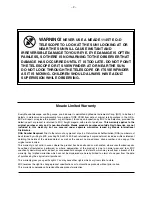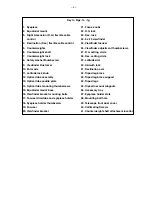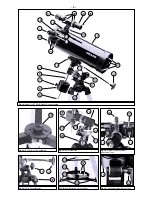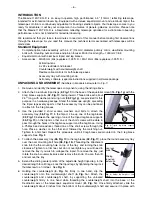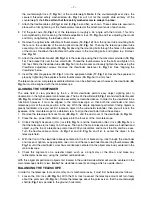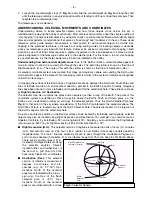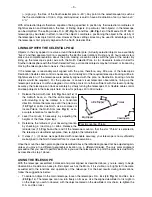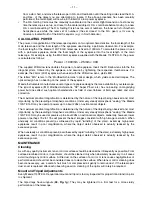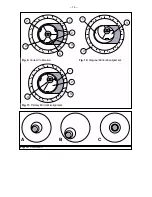
– 10 –
•
Always start an observation with a low power eyepiece (the MA 25mm eyepiece); get the object well-
centered in the field of view and sharply focused. Next, insert the MA 12mm eyepiece to try the next step
up in magnification. If the image starts to become fuzzy as you work into higher magnifications, then back
down to a lower power; the atmospheric steadiness is not sufficient to support high powers at the time
you are observing. Keep in mind that a bright, clearly resolved but smaller image will show far more detail
than a dimmer, poorly resolved larger image. The MA 25mm eyepiece included with the Meade 114ST
EQ-D presents a wide field of view, ideal for general astronomical observing of star fields, clusters of
stars, nebulae, and galaxies; it is also probably the best eyepiece to use in the initial finding and
centering of any object.
•
Once centered, the object can be focused by turning one of the knobs of the focusing mechanism (
21,
Fig. 1
). You will notice that the astronomical object in the field of view will begin to slowly move across
the eyepiece field. This motion is caused by the rotation of the Earth on its axis. To keep astronomical
objects centered in the field of the polar aligned telescope, simply turn the R.A. flexible cable control
(3,
Fig. 1e).
These objects will appear to move through the field more rapidly at higher powers. Note that the
Declination flexible cable control
(4, Fig. 1e)
is used only for centering purposes, and not for tracking.
•
Avoid touching the eyepiece while observing through the telescope. Vibrations resulting from such
contact will cause the image to move. Likewise, avoid observing sites where ground-based vibrations
may resonate the tripod. Viewing from the upper floors of a building may also introduce vibration.
•
You should allow a few minutes to allow your eyes to become “dark adapted” before attempting any
serious astronomical observations. Use a red filtered flashlight to protect your night vision when reading
star maps or inspecting the components of the telescope.
•
Avoid setting up the telescope inside a room and observing through an open window (or worse yet, a
closed window). Images viewed in such a manner may appear blurred or distorted due to temperature
differences between inside and outside air. Also, it is a good idea to allow your telescope a chance to
reach the ambient (surrounding) outside temperature before starting an observing session.
•
Avoid viewing objects low on the horizon–objects will appear better resolved with far greater contrast
when viewed higher in the sky. Also, if images appear to “shimmer” in the eyepiece–reduce power until
the image steadies. This condition is caused by air turbulence in the upper atmosphere. We repeat the
warning stated at the outset of this manual:
Never point the telescope directly at or near the Sun at any time! Observing the Sun, even for the
smallest fraction of a second, will result in instant and irreversible eye damage, as well as physical
damage to the telescope itself.
Astronomical software, such as StarNavigator, or a good star atlas, will assist you in locating many interesting
celestial objects. These objects include:
• Cloud belts across the surface of the planet Jupiter.
•
The 4 major moons of Jupiter, with the moons positions changing each night.
•
Saturn and its famous ring system, as well as several faint moons of Saturn.
•
The Moon: A veritable treasury of craters, mountain ranges and fault lines. The best time to view the
Moon is during its crescent phase. Image contrast during the full Moon phase is low and makes for
poor viewing due to the angle of illumination.
•
Deep-Space: Nebulae, galaxies, multiple star systems, star clusters–hundreds of such objects are
visible through the Meade 114ST EQ-D.
USING SETTING CIRCLES
Setting circles of the polar aligned equatorial mount can facilitate the location of faint celestial objects not
easily found by direct visual observation. To use the setting circles, follow this procedure:
•
Use a star chart or star atlas, and look up the celestial coordinates, Right Ascension and Declination
(R.A. and Dec.), of an easy-to-find bright star that is within the general vicinity of the faint object you
wish to locate.
•
Center the determined bright star in the telescope’s field of view.
•
Manually turn the R.A. setting circle (
27, Fig. 1c
) to read the R.A. of the object now in the telescope’s
eyepiece.
•
The setting circles are now calibrated (the Dec. setting circle (
28, Fig. 1c
) is factory calibrated). To
locate a nearby faint object using the setting circles determine the faint object’s celestial coordinates


